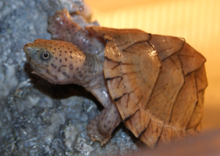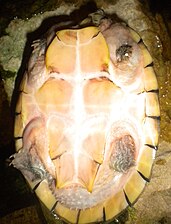| This article needs additional citations for verification. Please help improve this article by adding citations to reliable sources. Unsourced material may be challenged and removed. Find sources: "Razor-backed musk turtle" – news · newspapers · books · scholar · JSTOR (August 2011) (Learn how and when to remove this message) |
| Razor-backed musk turtle | |
|---|---|

| |
| Adult | |

| |
| Young | |
| Conservation status | |
 Least Concern (IUCN 3.1) | |
| Scientific classification | |
| Domain: | Eukaryota |
| Kingdom: | Animalia |
| Phylum: | Chordata |
| Class: | Reptilia |
| Order: | Testudines |
| Suborder: | Cryptodira |
| Family: | Kinosternidae |
| Genus: | Sternotherus |
| Species: | S. carinatus |
| Binomial name | |
| Sternotherus carinatus (Gray, 1856) | |

| |
| Synonyms | |
List
| |
The razor-backed musk turtle (Sternotherus carinatus) is a species of turtle in the family Kinosternidae. The species is native to the southern United States. There are no subspecies that are recognized as being valid.
Geographic range
S. carinatus is found in the states of Alabama, Arkansas, Louisiana, Mississippi, Oklahoma, Florida, and Texas.
Description
The razor-backed musk turtle grows to a straight carapace length of about 15 cm (5.9 in). It has a brown-colored carapace, with black markings at the edges of each scute. The carapace has a distinct, sharp keel down the center of its length, giving the species its common name.
The body is typically grey-brown in color, with black spotting, as is the head, which tends to have a bulbous shape to it. It has a long neck, short legs, and a sharp beak. Males can usually be distinguished from females by their longer tails.
The plastron is small, with only one hinge which is located anteriorly. There is no gular scute. Barbels are present on the chin only.
Behavior
S. carinatus is almost entirely aquatic, spending most of its time in shallow, heavily vegetated, slow-moving creeks, ponds, streams, and swamps. The only time it typically ventures onto land is when the female lays eggs. However, both sexes bask often.
Diet
The diet of S. carinatus consists primarily of aquatic invertebrates, including freshwater clams, crayfish, snails, and various insects. It also feeds on fish, amphibians, carrion, seeds, and aquatic plants.
In captivity
The razor-backed musk turtle is frequently kept in captivity, and is regularly captive bred. Its relatively small size, hardiness and ease of care makes it a more attractive choice as a pet turtle for many keepers, than the more commonly available red-eared slider (Trachemys scripta elegans). There is disagreement in sources how old musk turtles can get in captivity with estimates ranging between 20 and 50 years.
-
 Texas
Texas
-
 Texas
Texas
-
 Texas
Texas
-
 Hatchling, Texas
Hatchling, Texas
-
 Hatchling, Texas
Hatchling, Texas
-
 In captivity
In captivity
-
 Hybrid with the eastern musk turtle
Hybrid with the eastern musk turtle
References
- van Dijk, P.P. (2016) . "Sternotherus carinatus". IUCN Red List of Threatened Species. 2011: e.T170492A97383360. doi:10.2305/IUCN.UK.2011-1.RLTS.T170492A6781357.en. Retrieved 3 July 2023.
- Fritz, Uwe; Havaš, Peter (2007). "Checklist of Chelonians of the World". Vertebrate Zoology. 57 (2): 262. doi:10.3897/vz.57.e30895. ISSN 1864-5755.
- ^ "Sternotherus carinatus ". The Reptile Database. www.reptile-database.org
- Behler JL, King FW (1979). The Audubon Society Field Guide to North American Reptiles and Amphibians. New York: Alfred A. Knopf. 743 pp., 657 colored plates. ISBN 0-394-50824-6. (Sternotherus carinatus, p. 443 + Plate 310).
- ^ Conant R (1975). A Field Guide to Reptiles and Amphibians of Eastern and Central North America, Second Edition. Boston: Houghton Mifflin. xviii + 429 pp. ISBN 0-395-19979-4 (hardcover), ISBN 0-395-19977-8 (paperback). (Sternotherus carinatus, pp. 41, 46 (Fig. 7) + Plate 4 + Map 9).
- Smith HM, Brodie ED Jr (1982). Reptiles of North America: A Guide to Field Identification. New York: Golden Press. 240 pp. ISBN 0-307-47009-1 (hardcover), ISBN 0-307-13666-3 (paperback). (Sternotherus carinatus, pp. 28–29).
- ^ Mossburg, Chelsea (2015). Jordan, Mark (ed.). "Sternotherus carinatus (Razorback Musk Turtle)". Animal Diversity Web. Retrieved 3 July 2023.
- Atkinson, Carla L. (2013). "Razor-Backed Musk Turtle (Sternotherus carinatus) Diet Across a Gradient of Invasion". Herpetological Conservation and Biology 8 (3): 561–570.
- ^ "Turtles that Stay Small: Finding the Perfect Pet Turtle". Pet Territory. 2018-07-25. Retrieved 2019-07-25.
- "Common Musk Turtle Care Sheet". www.reptilesmagazine.com. 3 December 2013. Retrieved 2019-07-25.
Further reading
- Boulenger GA (1889). Catalogue of the Chelonians, Rhynchocephalians, and Crocodiles in the British Museum (Natural History). New Edition. London: Trustees of the British Museum (Natural History). (Taylor and Francis, printers). x + 311 pp. + Plates I–VI. (Cinosternum carinatum, p. 38).
- Carr AF (1952). Handbook of Turtles: The Turtles of the United States, Canada, and Baja California. Ithaca, New York: Comstock Publishing Associates, a Division of Cornell University Press. 542 pp.
- Goin CJ, Goin OB, Zug GR (1978). Introduction to Herpetology, Third Edition. San Francisco: W.H. Freeman. xi + 378 pp. ISBN 0-7167-0020-4. (Sternotherus carinatus, p. 263).
- Gray JE (1856). "On some New Species of Freshwater Tortoises from North America, Ceylon and Australia". Annals and Magazine of Natural History, Second Series 18: 263–268. (Aromochelys carinata, new species, p. 266).
- Powell R, Conant R, Collins JT (2016). Peterson Field Guide to Reptiles and Amphibians of Eastern and Central North America, Fourth Edition. Boston and New York: Houghton Mifflin Harcourt. xiv + 494 pp., 47 plates, 207 figures. ISBN 978-0-544-12997-9. (Sternotherus carinatus, pp. 227–228 + Plate 19 + Figures 86, 104).
- Stejneger L, Barbour T (1917). A Check List of North American Amphibians and Reptiles. Cambridge, Massachusetts: Harvard University Press. 125 pp. (Kinosternon carinatum, p. 111).
- Tinkle DW, Webb RG (1955). "A new species of Sternotherus with a discussion of the Sternotherus carinatus complex (Chelonia, Kinosternidae)". Tulane Studies in Zoology 3 (3): 53–67.
External links
| Kinosternidae family | |||
|---|---|---|---|
| |||
| Genera |
| ||
| Claudius | |||
| †Hoplochelys | |||
| Kinosternon |
| ||
| Sternotherus | |||
| Staurotypus | |||
| Phylogenetic arrangement of turtles based on turtles of the world 2017 update: Annotated checklist and atlas of taxonomy, synonymy, distribution, and conservation status. Key: †=extinct. | |||
| Taxon identifiers | |
|---|---|
| Sternotherus carinatus |
|


